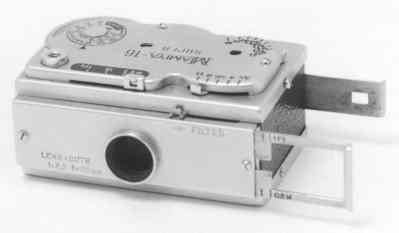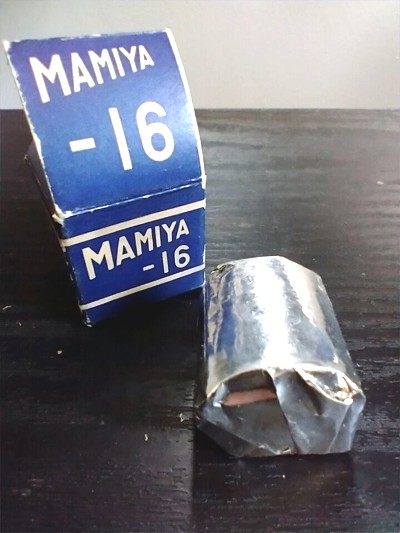
MAMIYA 16mm CAMERAS


In addition, Mamiya also made many cosmetic changes within each particular camera model. In other words, your Super 16 II probably will not look exactly like your neighbor's Super 16 II. These differences are not well documented, and the various idiosyncratic types are prized by collectors.
(1949-1950) -- 25mm (f3.5-11); B, 1/25-1/100. Talk about tiny! The first Mamiya submini had a fixed focus lens. It came with two close up lenses and two filters that slid onto the front of the lens. The viewfinder popped out of one end and uncovered the lens at the same time. Apparently a black model was also made. Originally designed to use two cassettes, but the later single-piece cassette will work as well.
(1949) -- 25mm (f3.5-11); B, 1/25-1/100 . Same as the original but in black with a clip-on waist-level finder. This model is very rare.
By 1950, Mamiya knew they had a winner with the Mamiya 16 so in 1951 they produced an updated version and called it the Mamiya Super 16. Although it looked the same as the original, and had the same lens -- a 25mm four-element (f3.5-11) -- this version made several significant changes. First, the lens was changed to a focusing lens. An engraved scale on the top of the camera allows focusing from infinity to 0.3 meters. And the pop-out viewfinder now has parallax correction! In addition, the shutter had a wider range of shutter speeds -- B, 1/2-1/200. Third, a built-in, slide-in filter-holder was added to the front of the lens. A little lever on the front of the camera slides the filter in and out, while a tiny trap-door on the bottom allows the filter to be changed. Mamiya made several round filters that can be used on this camera: yellow, green, red, skylight, 85B, and neutral density. Finally, this model has the added advantage of flash synch -- but it's not a standard PC connector. The flash contact screws into the bottom of the camera -- inside the tripod socket! So it will only work with special flash gear, but this connection can also be used as a regular tripod socket. At this point, Mamiya decided to switch from the original cassette pairs to a new, single-piece cassette. Although this was more convenient than the cassette pairs, in some ways, this doomed the camera series. At the time, there were many companies offering 16mm cameras and all used different cassette systems. It was difficult for every camera shop to offer every type of film and camera. Many would only offer the most popular types. Mamiya lost this battle, even though their cameras offered a surprising number of features in a tiny package and produced excellent results. Mamiya staked a lot on this model. It was made until 1956, and with six years of production is the most common version. It's not easy to identify a Super 16 (Model I) though -- it's only marked Super 16, but without the "Model I". You can tell if you have a Model I because it's marked "Super 16" and only three f-stops are marked: f3.5, f5.6 and f11. On all other Super 16 models, all of the f-stops are marked. A few of the earliest Model I cameras (early 1951) are marked "Made in Occupied Japan" on the back of the camera. The camera was often sold in a kit with three rolls of film, camera case, flash attachment and flash bulbs. Here's a depth-of-field chart.
(1959) -- 25mm (f3.5-11); B, 1/2-1/200 . It's a Mamiya 16 Super Model III marketed by Sears. It it marked "TOWER", as many cameras sold by Sears were -- not "MAMIYA". These tend to get pricey, since they are more unusual -- and so sought after by collectors. Here's a depth-of-field chart.
Same as the Mamiya 16 Automatic but with a different nameplate.
(1962) -- 25mm (f2.8-16); B, 1/5-1/200 . Basically an updated version of the 16 Automatic, it had a built-in match-needle selenium meter that was coupled to the f-stop. The last of the Mamiya subminis, it was still substantially bigger than the original models. Like the 16 Automatic, it too had a pop-up viewfinder. It maintained many of the features of the original, such as a focusing lens and built-in sliding filter, but it replaced the slide-in yellow filter with a slide-in neutral density (4X, or 2 f-stops) filter.

To return to the main index for the Sub Club click here.
COPYRIGHT @ 1995, 1996, 1997, 1998, 1999, 2000, 2001, 2002, 2003, 2004, 2005 by Joe McGloin. All Rights Reserved.